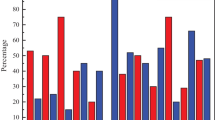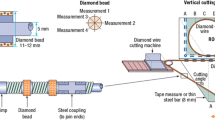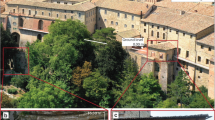Abstract
The performance of large-diameter circular saws on eight carbonate rocks was recorded and indentation hardness, density and porosity tests were undertaken on the five travertines, two limestone and one dolomitic limestone samples returned to the laboratory. A strong linear correlation between indentation hardness index values and the hourly production of the circular saws was found. The slab production was slowest for the dolomitic limestone rocks with the highest indentation hardness, lowest porosity and highest density values.
Résumé
Les performances de scies circulaires de grand diamètre, pour la découpe de huit roches carbonatées représentées par cinq travertins, deux calcaires et un calcaire dolomitique ont été enregistrées. La densité, la porosité et un paramètre de résistance à l’indentation ont été mesurés au laboratoire sur les échantillons correspondants. Une forte corrélation linéaire entre l’indice de résistance à l’indentation et la production horaire des scies circulaires a été trouvée. La production de plaques était la plus faible pour les calcaires dolomitiques qui présentaient les plus fortes résistances à l’indentation, les plus faibles porosités et les plus fortes densités.
Similar content being viewed by others
Explore related subjects
Discover the latest articles, news and stories from top researchers in related subjects.Avoid common mistakes on your manuscript.
Introduction
Natural stone products are widely used as construction and decorative materials. There is a steadily increasing market demand for stone products all over the world today. Between 1986 and 2006, world facing stone production increased by 218%, rising from 275 to 880 million m2 and it is highly probable that the sector will continue to grow at an even higher rate in the next decade (I-STONE 2007).
Large-diameter circular saws have been extensively used in stone processing plants. The prediction of rock sawability is important in the cost estimation and the planning. Recently, Ribeiro et al. (2007) showed that the texture of the rock has the most important influence on the cost of production of polished slabs. Rock sawability depends on machine characteristics, type and diameter of saw, depth of cut, rate of sawing and toolwear, and rock properties. A number of researchers (Burgess 1978; Wright and Cassapi 1985; Ceylanoglu and Gorgulu 1997; Brook 2002; Wie et al. 2003; Eyuboglu et al. 2003; Ersoy and Atici 2004; Gunaydin et al. 2004; Kahraman et al. 2004, 2006; Delgado et al. 2005; Fener et al. 2007) have established correlations between sawability and some rock properties, but to the writer’s knowledge there have been no investigations into a correlation between sawability and the relatively cheap and simple indentation hardness test. This test is particularly useful when only a limited amount of rock material is available, e.g. a thin disc of core or a small lump sample (Szwedzicki 1998a).
A standard indentation test was suggested by ISRM (Szwedzicki 1998a) as a measure of hardness and Szwedzicki (1998b) evaluated its use in estimating uniaxial compressive strength. The test involves applying a load such that an “indentor” penetrates into the rock surface. The resulting index value characterises rock hardness and may be used for assessing some strength properties such as uniaxial compressive and tensile strength as well as the drillability or cuttability of rocks (Szwedzicki 1998a)
In this study, the use of the indentation hardness test to predict sawability was investigated, using a dial gauge attached to the point load apparatus to measure the penetration.
Field studies
Marble factories in the Kayseri, Konya and Antalya areas of Turkey were visited and the sawing performance of large-diameter circular saws measured on eight different carbonate rocks (Table 1). A typical block cutting machine is shown in Fig. 1. The diameter and revolutions per minute of the saw (measured using a stroboscope), the advance rate, the depth of the cut, the dimensions of the slabs, the number of slabs cut per hour, etc. were recorded (see Table 1).
Laboratory studies
Having observed the cutting at the various factories, samples of the various materials, large enough to undertake the required laboratory studies, were obtained. Each block sample was inspected for macroscopic defects to ensure that the test specimens were free from fractures, partings or alteration zones. Summaries of indentation hardness, density and porosity testing are given in Table 2.
Indentation hardness test
The indentation hardness test in ISRM (Szwedzicki 1998a, b) requires a loading system having a capacity of 30 kN and a conical platen having a 60° cone and 5 mm radius spherical tip, hence the point load apparatus is suitable for this purpose. After attaching a dial gauge to the point load apparatus the measuring penetration, indentation hardness tests can be carried out (Fig. 2).
NX core samples having a height to diameter ratio of at least 0.75:1 were used in the tests. ISRM suggested that the disk sample can be cemented into a steel frame with a high-grade plaster with a compressive strength of 35–40 MPa. In this study, the samples were cemented into a steel frame using a high-grade plaster with a compressive strength of 60.6 MPa (Fig. 3). The samples were placed on the lower platen of the point load apparatus and loaded to 20 kN. The corresponding penetration was read from the dial gauge (Fig. 2). Indentation Hardness Index (IHI) values were calculated by dividing the maximum load (kN) by the maximum penetration (mm). The tests were repeated at least three times for each rock type and the average value recorded as the IHI (Table 2).
Density test
The determination of dry density was carried out on trimmed core samples. The volume was established on an average of several calliper readings and the sample weighed on a balance with an accuracy of 0.01 of the sample weight. The density values were obtained from the ratio of the specimen weight to the specimen volume. The results are given in Table 2.
Porosity test
Porosity values were determined using saturation and calliper techniques. Pore volumes were calculated from dry and saturated weights and sample volumes as for the density tests. The porosity values were obtained from the ratio of the pore volumes to the specimen volume. The results are given in Table 2.
Statistical analysis
Simple regression analysis
Hourly production and IHI values were correlated using least squares regression. Linear, logarithmic, exponential and power curve fitting was undertaken and the best approximation equation with highest correlation coefficient determined. A linear inverse relationship was found between hourly production and IHI values (Fig. 4). The equation of the line is:
where P h is the hourly production (m2/h) and IHI is the indentation hardness values (kN/mm).
Multiple regression analysis
Multiple linear regression analysis was also undertaken, including density and porosity in the model. The derived equations for the estimation of hourly production were
where P h is the hourly production (m2/h), IHI is the indentation hardness values (kN/mm), γ is the density (g/cm3) and n is the porosity (%).
Discussion
Hourly production values strongly correlated with IHI values (r 2 = 0.77 for simple regression and 0.80, 0.79 and 0.90 for the multiple regression analyses). Equation (1) is realistic for the estimation of sawability, although using Eq. (4) (which includes density and porosity) gives a more accurate result.
Comparing Tables 1 and 2, it is noted that the slowest cut is related to the lowest porosity and highest density and the fastest cut with the highest porosity and second lowest density. This is due to the fact that the increasing porosity or decreasing density generally decreases the strength and hardness of rocks. It is known that there is a clear relation between sawability and strength properties such as uniaxial compressive strength (UCS), tensile strength and point load strength (Fener et al. 2007; Ceylanoglu and Gorgulu 1997). Therefore, the sawing rate of high strength rocks generally having low porosity and high density will be less than that of low strength rocks. In addition, Szwedzicki (1998b) notes that there is a strong relationship between IHI and UCS thus a correlation between sawability and IHI would be expected.
Gunaydin et al. (2004) derived some prediction equations for sawability from different brittleness values and Fener et al. (2007) from Schmidt hammer, point load, impact strength, and sound velocity tests. However, brittleness is a much more difficult test to undertake compared with the indentation hardness index while the equations derived by Fener et al. are not as strong as those derived in the present study.
Conclusions
Indentation hardness index values have been correlated with the hourly production in diamond sawing for eight carbonate rocks (five travertines, two limestones and a dolomitic limestone). The correlation coefficients derived using multiple regression models were generally higher than those obtained using simple regression which had a correlation coefficient of 0.77.
It is considered that, for practical purposes, the relatively cheap and simple indentation hardness test, which can be undertaken using point load apparatus, provides a useful indication of sawability.
References
Brook B (2002) Principles of diamond tool technology for sawing rock. Int J Rock Mech Min Sci 39:41–58
Burgess RB (1978) Circular sawing granite with diamond saw blades. In: Proceedings of the 5th industrial diamond seminar, pp 3–10
Ceylanoglu A, Gorgulu K (1997) The performance measurement results of stone cutting machines and their relations with some material properties. In: Proceedings of the 6th international symposium on Mine Plann Equip Select, pp 393–398
Delgado NS, Rodriguez-Rey A, Rio LMS, Sarria ID, Calleja L, Argandona VGR (2005) The influence of microhardness on the sawability of Pink Porrino granite (Spain). Int J Rock Mech Min Sci 42:161–166
Ersoy A, Atici U (2004) Performance characteristics of circular diamond saws in cutting different types of rocks. Diamond Relat Mater 13:22–37
Eyuboglu AS, Ozcelik Y, Kulaksiz S, Engin IC (2003) Statistical and microscopic investigation of disc segment wear related to sawing Ankara andesites. Int J Rock Mech Min Sci 40:405–414
Fener M, Kahraman S, Ozder MO (2007) Performance prediction of circular diamond saws from mechanical rock properties in cutting carbonate rocks. Rock Mech Rock Eng 40(5):505–517
Gunaydin O, Kahraman S, Fener M (2004) Sawability prediction of carbonate rocks from brittleness indexes. J South Afr Inst Min Metall 104:239–243
I-STONE (2007). http://www.istone.ntua.gr/Objectives.html. 5 October 2007
Kahraman S, Fener M, Gunaydin O (2004) Predicting the sawability of carbonate rocks using multiple curvilinear regression analysis. Int J Rock Mech Min Sci 41:1123–1131
Kahraman S, Altun H, Tezekici BS, Fener M (2006) Sawability prediction of carbonate rocks from shear strength parameters using artificial neural networks. Int J Rock Mech Min Sci 43:157–164
Ribeiro RP, Paraguassu AB, Rodrigues JE (2007) Sawing of blocks of siliceous dimension stone: influence of texture and mineralogy. Bull Eng Geol Env 66:101–107
Szwedzicki T (1998a) Draft ISRM suggested methods for determining the indentation hardness index of rock materials. Int J Rock Mech Min Sci 35:831–835
Szwedzicki T (1998b) Indentation hardness testing of rock. Int J Rock Mech Min Sci 35:825–829
Wie X, Wang CY, Zhou Z-H (2003) Study on the fuzzy ranking of granite sawability. J Mater Process Technol 139:277–280
Wright DN, Cassapi VB (1985) Factors influencing stone sawability. Ind Diamond Rev 2:84–87
Acknowledgments
Authors are deeply grateful to Nigde University Research Fund for the financial support. The authors wish to acknowledge Kamer Mermer, Derinkok Mermer, Toros Mermer, Akmeras Mermer and Kombassan Mermer for providing facilities for the performance measurements. This work has been partly supported by the Turkish Academy of Sciences, in the framework of the Young Scientist Award Program (EA-TUBA-GEBIP/2001-1-1).
Author information
Authors and Affiliations
Corresponding author
Rights and permissions
About this article
Cite this article
Kahraman, S., Gunaydin, O. Indentation hardness test to estimate the sawability of carbonate rocks. Bull Eng Geol Environ 67, 507–511 (2008). https://doi.org/10.1007/s10064-008-0162-1
Received:
Accepted:
Published:
Issue Date:
DOI: https://doi.org/10.1007/s10064-008-0162-1








